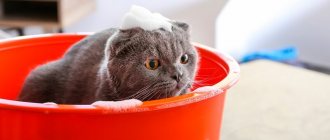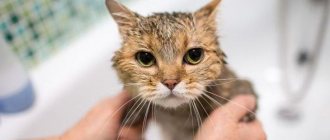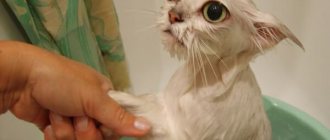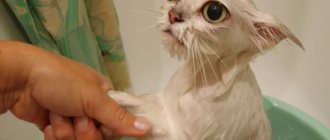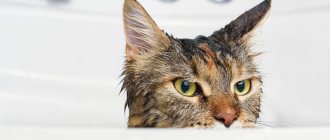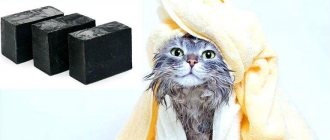Cat breed
: yard.
Asks : Basilisk the Beautiful. The essence of the question : how to bathe a cat if there is no shampoo?
Our cat ran outside in the morning, for the first time in 5 years. The cat is neutered, we were surprised ourselves. Came in the evening of the same day. We wanted to give him a bath yesterday, we don’t know where he was climbing. And we don't even have cat shampoo. And there are no veterinarians nearby either.
Is it possible to bathe a cat with regular shampoo or soap?
Among many cat lovers, there is an opinion that pets should not be bathed, but sometimes there is an urgent need to wash the cat. And these are not only cases when the animal has caught fleas or is very dirty, but also, for example, preparation for an exhibition.
Is it possible to bathe a cat?
It’s true that you shouldn’t bathe cats often. The optimal amount of water treatments for domestic cats that do not leave the apartment is 3-4 times a year. After each bath, the cat's fur should be wiped dry with a non-hard towel.
Cats should not be bathed often.
Owners whose pets do not take part in exhibitions do not often bathe their pets. Therefore, they may be faced with a situation where the animal is very dirty or has fleas and other parasites, and there is no special shampoo for cats available.
What products, besides special shampoo, can be used to wash cats?
Cats have very sensitive and delicate skin, and their acid-base balance is very different from human ones. That is why, if you decide to wash your pet with your regular shampoo, you should choose the mildest possible product.
The ideal option is a shampoo for children that does not contain substances that can lead to dry skin and coat.
The ideal option is shampoo for children.
An incorrectly selected cat wash product can result in such unpleasant consequences as:
- skin irritation;
- deterioration of coat condition. If the product is not chosen correctly, the cat's fur can become brittle and dull;
- hair loss.
It is recommended to wash your cat with shampoo if you want to give its fur a beautiful and well-groomed look. If the animal just gets dirty, then you can wash off the dirt with clean warm water . To do this, just wet a piece of soft cloth in water and thoroughly wipe your pet, paying special attention to contaminated areas.
When is it not recommended to bathe cats?
There are situations in which bathing a cat can lead to dangerous consequences for its health. These include cases such as:
- old age of the animal . Such cats and cats are more susceptible to stress than young individuals, and every bath can be a serious test for their nervous system;
- the animal has recently undergone surgery ;
- There is cold air in the apartment or constant drafts . In this case, the pet may freeze and catch a cold after swimming in warm water.
It is not recommended to bathe older cats.
In most cases, cats are able to keep themselves clean without water or shampoo. To prevent fur from accumulating in the furry pet’s stomach after active licking, owners should give it special vitamins that help remove fur naturally.
How to wash a cat if there is no special shampoo
For regular care of animals, special products are needed. They are less aggressive in composition than regular shampoos. It is best to wash the cat with warm water and beaten egg yolk. If that doesn’t work, you need compounds with PVA.
In rare cases, you can wash cats with regular shampoo or soap, but it is not advisable to do this often. The animal's skin will begin to peel off.
Let's discuss what to choose from what is in the bathroom.
Regular soap
It is not recommended to bathe a kitten with soap with a strong fruity or floral aroma. Bath, pine, and baby soap are preferable. Experienced veterinarians do not advise excessive soaping of the animal.
It is enough to pour it with soapy water or apply foam to the wool. If the surfactants (surfactants) don't touch the skin, great.
You shouldn't bathe your pet too hard. He must have natural protection.
Baby shampoo
Products used to wash children under three years of age are hypoallergenic. They contain less of all kinds of synthetic additives and more natural ingredients. But you can’t get carried away with them either.
The product is pre-diluted 1:3 and foamed well. And then the kitten is treated with foam. You need to carefully clean the face.
Phrases like “washes without tears” are a marketing ploy. When foam gets into the eyes of animals, conjunctivitis develops. The small pet will become restless. Ears are a no-go area. They are cleaned with ear sticks with water, lotion or saline solution.
Regular human shampoo
Some owners use human shampoo to care for their pets, and do this regularly. Veterinarians strictly prohibit doing this. The secretion of fatty glands is disrupted, the skin suffers, and the structure of the hairs changes.
Allergic dermatitis and other skin diseases are possible. Immunity weakens. After washing, cats get sick more often and can get pneumonia.
If there are several hair care products, choose the simplest one. It is better if it contains a decoction of herbs, without dyes or thickeners.
The soap composition is made by diluting the shampoo with water, increasing the volume at least five times. In this case, it will be possible to protect the cat from the consequences and reduce the risk of developing skin diseases.
Tar shampoo or liquid soap
Tar is an excellent folk remedy for skin irritation. Liquid soap or tar shampoo is a good insecticidal remedy for blood-sucking insects.
If your pet constantly scratches itself with its paws or bites something out of its fur, it may have fleas. Try washing it with tar soap. This primitive method is used in folk medicine.
conclusions
For regular use, it is better to purchase a special shampoo for cats.
If you nevertheless decide to bathe your pet and use human shampoo for this, then thoroughly wash the animal’s fur. Otherwise, when licking itself after bathing, the animal may lick off the product that remains on the fur and become seriously poisoned.
Washing with regular shampoo can be practiced only in case of one-time bathing of the pet. If you plan to subject your cat to regular water treatments, it is better to purchase a special cat shampoo.
The importance of choosing the right detergent for your furry pet
If the shampoo is chosen incorrectly, it will negatively affect the condition of the cat's coat.
The hair will become brittle, dull, begin to get tangled, and form clumps. The skin condition may worsen. When using inappropriate products, the dermis becomes dry and there is a risk of dandruff.
It is important to take a responsible approach to choosing shampoo.
Your pet needs to be given proper care to avoid problems with its fur and skin . Responsibility for the health of the animal lies with the person.
How to treat a cat?
Nature has created the cat breed in such a way that they themselves try to maintain their cleanliness by constantly licking their fur and maintaining personal hygiene. However, there are many situations when it is extremely necessary to bathe an adult cat or a small kitten. One of these problems is the presence of a large number of fleas on an animal brought home.
A large number of chemical products have been created for animals to kill fleas, but most of them are very highly toxic drugs, and for a small kitten very harmful to health and life. Therefore, the best way to get rid of fleas is to bathe the kitten with a special anti-flea shampoo containing insecticides.
Such chemicals (permethrin, etofenprox, phenothrin, etc.) are designed specifically to combat parasites and harmful insects.
Insecticide shampoos
When purchasing flea shampoo in a store, you need to carefully read the label, production dates and guarantees of this chemical product. Also, instructions are always added to them, telling in detail about its composition and principles of action, for cats of what age it can be used.
You can bathe kittens with flea shampoo only with a special one designed specifically for feline babies, because in high concentrations the chemicals can have harmful effects. Lugovoi, Bars and other shampoos have proven themselves well.
In addition to the main elements, various oils, plant extracts and minerals are also added to the shampoo, which help improve the structure of the cat's hair and its shine, which has a beneficial effect on the skin.
Insecticidal shampoos have varying degrees of effect on parasites depending on the age and weight of the cat.
When asked how often you can wash your cat with flea shampoo, you can answer: “depending on the situation.” Frequently washing and treating an animal is only possible if there are a large number of fleas in the fur. It is also necessary to check the instructions for the purchased product, which indicate the minimum period for re-processing.
How to bathe a cat or kitten
Before starting this procedure, you need to take into account that both small kittens and adult cats are often afraid of water procedures, and bathing is very stressful for them (although there are exceptions when they love to squish in the water and even jump into the washbasin for a bath).
How to wash a kitten with flea shampoo - sequence of steps:
- Prepare: a small basin and a bottle of shampoo;
- The water should be warm (in no case hot);
- Place the baby in the basin, holding it with one hand (so as not to run away) and thoroughly moisten the fur;
Important!
When washing, do not allow water or anti-flea shampoo to get into the cat's ears or eyes to avoid irritation.
Review
My daughter and I found a small and very flea-covered beautiful cat in the yard and brought it home. The first item on the agenda was flea removal. We bought an inexpensive special shampoo and performed water treatments that same evening. There were a lot of screams and fleas too, and then they combed them out by the dozens. A week later the treatment was repeated, because... There were still a few unkilled individuals left. And now we live with a clean and well-groomed fluffy beauty, whom my daughter loves very much.
Valeria, St. Petersburg
How often can you wash
To understand whether the shampoo has worked and whether re-treatment is necessary if fleas remain, the fur must be carefully examined for 1-3 days. If you come across dead fleas, it is better to carefully comb them out and throw them away.
You also need to inspect the animal for:
- An allergic reaction to a chemical (usually manifested by skin rashes);
- The presence of surviving fleas;
- How well is the processing done?
Based on the results obtained, you need to decide whether you need to bathe the kitten again with flea shampoo, or whether you need to change the anti-flea shampoo and try another one. Manufacturers usually indicate on the bottle how many days later the treatment can be repeated - most often it is 10 days.
If a certain number of fleas still survive, then it is better to repeat the treatment.
Important!
If after bathing the kitten develops rashes on its skin, this means that the components of the shampoo caused an allergic reaction, and it is better not to use this product in the future.
Treatment of adult cats
Adult cats also often get fleas, especially in the summer. You need to wash your cat with flea shampoo depending on the situation:
- The cat forgets to lick itself in some places (butt, ears, tail);
- A cat regularly goes outside, so it gets dirty and brings new flea-infested “tenants”;
- Even clean (not going outside) domestic cats can acquire fleas that enter the apartment from basements, staircases, and on the shoes of people who come in.
When a cat brings fleas into the house, you should wash it with a special product as quickly as possible. To wash a cat from fleas, follow a method similar to water procedures for kittens, only the shampoo is purchased based on adult cats.
You should also consider the following factors before swimming:
- The presence or absence of heating (in the cold season), drafts;
- Only a healthy animal with normal immunity can be bathed;
- You cannot wash animals that have been vaccinated the day before;
- During pregnancy, a cat (especially if she is very afraid of water) should be bathed only when strictly necessary, otherwise a miscarriage can be caused.
How to teach a cat to bathe
Cats accustomed to bathing from childhood tolerate the procedure calmly.
You should take care that your pet is not afraid of water even in his childhood. An animal should be accustomed to bathing gradually, starting with periodic washing of its paws. Everything should take place without haste and fuss - the procedure should remain in the cat’s memory as something harmless.
You can find out more about why cats are afraid of water here:
It is recommended to fully bathe an animal for the first time at six months of age, that is, 2–3 weeks after the complete replacement of baby teeth. During the process, animal psychologists recommend talking gently to your pet in order to calm him down and create a trusting atmosphere.
Manipulations associated with drying wool should also be comfortable for the animal. It is not recommended to wipe it with vigorous massage movements: the cat may consider this an insult, not to mention the fact that it is simply unpleasant. It is better to gently blot the wet fur coat with a soft towel for several minutes.
It will be great if you can overcome your cat's fear of a hair dryer. It is better to accustom your pet to a noisy device from the first year of life. Including the device, you must:
- set the “warm” mode;
- first “buzz” at some distance from the animal, gradually bringing the hair dryer closer;
- blow on the cat, lightly stroking its fur: this will help reduce anxiety and also allow you to control the distance from the hair dryer to the fur and the temperature of the flow. If the air is too hot and hairs get into the device, the frightened cat will hide from the hair dryer for the rest of its life.
It is not easy to accustom an adult animal to bathing and subsequent drying. Each procedure should be pleasant for the pet and should not be associated with fear, discomfort and pain.
Bathing with shampoo as a flea prevention
In a situation where parasites are not found in the animal’s fur upon visual inspection, washing the cat with flea shampoo is often not recommended. This is due to the anatomical features of the structure of cat skin.
The epidermis of cats does not have sweat glands. To protect against dry skin cells, the sebaceous glands secrete a very small amount of secretion that lubricates the skin. With too frequent bathing procedures with ordinary tap water (which is very hard), the protective layer on the skin is washed off, it dries out, begins to peel and crack, which can lead to partial hair loss of the animal.
Experts recommend carrying out preventive treatment against parasites for cats and female cats 2-3 times a year.
https://mykoshka.ru/pomyt-kota-esli-net-specialnogo-shampunya https://apest.ru/blohi/blohi-u-koshek/kak-myt-koshku-shampunem-ot-bloh/
Mr. Cat recommends: what products to use to bathe a cat
In order not to harm the condition of your pet’s fur and skin, you need to choose the right shampoo.
- Shampoo is available for oily and dry skin. In the latter case, they reduce the formation of static, add shine, and nourish. Some products contain sebum, that is, a fat-like substance that is secreted by the sebaceous glands, as a result of which the coat is covered with a protective layer. If your pet has oily skin, shampoo helps remove excess oil.
- If your pet has unkempt fur, you should choose a shampoo to remove tangles. The mechanism of action is that positively charged components come into contact with negatively charged hairs, causing the clumps to unravel. The product also gives a healthy shine and elasticity to the coat.
- Tinting shampoo is usually used in preparation for an exhibition to give the coat a pronounced shine and deepen the color. Such products contain coloring pigments that interact unstable with the hair, due to which they are gradually washed off from the pet’s fur. The use of such shampoos for bathing spotted cats is not recommended, as the white areas of the coat may lose their color.
- Lightening agent is used to whiten stains. Most often used before an exhibition.
- A special shampoo for breeds without hair, designed for high-quality skin care. Such products are presented in small quantities on the domestic market, and are also high in cost, so they can be replaced with children's hypoallergenic shampoo.
- Specialized medicinal shampoos are prescribed by a veterinarian to treat skin infections, treat fleas and lice.
For cats that really don’t like to wash themselves, spray or dry shampoos have been created. It is enough to spray them on the wool, and after a few minutes comb it.
Cat bath products are used according to the instructions; if side effects occur or if the contents get into the eyes, ears or nose, you should contact a veterinarian.
